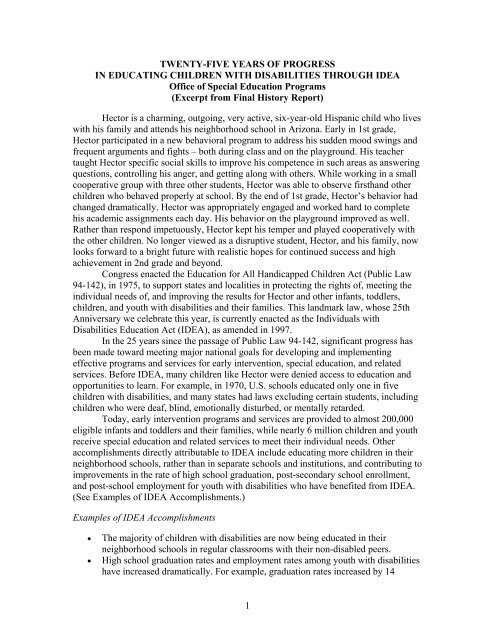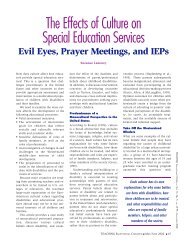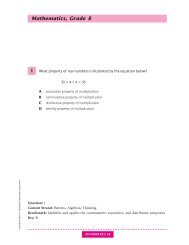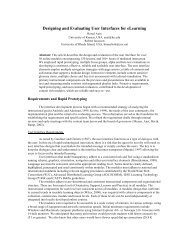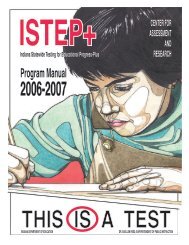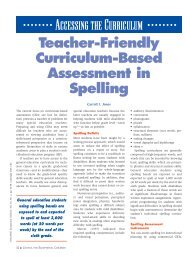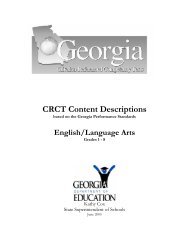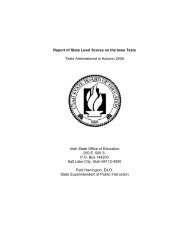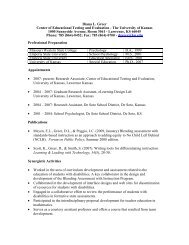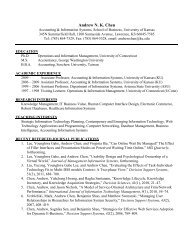Twenty-five years of progress in educating children with disabilities ...
Twenty-five years of progress in educating children with disabilities ...
Twenty-five years of progress in educating children with disabilities ...
Create successful ePaper yourself
Turn your PDF publications into a flip-book with our unique Google optimized e-Paper software.
TWENTY-FIVE YEARS OF PROGRESS<br />
IN EDUCATING CHILDREN WITH DISABILITIES THROUGH IDEA<br />
Office <strong>of</strong> Special Education Programs<br />
(Excerpt from F<strong>in</strong>al History Report)<br />
Hector is a charm<strong>in</strong>g, outgo<strong>in</strong>g, very active, six-year-old Hispanic child who lives<br />
<strong>with</strong> his family and attends his neighborhood school <strong>in</strong> Arizona. Early <strong>in</strong> 1st grade,<br />
Hector participated <strong>in</strong> a new behavioral program to address his sudden mood sw<strong>in</strong>gs and<br />
frequent arguments and fights – both dur<strong>in</strong>g class and on the playground. His teacher<br />
taught Hector specific social skills to improve his competence <strong>in</strong> such areas as answer<strong>in</strong>g<br />
questions, controll<strong>in</strong>g his anger, and gett<strong>in</strong>g along <strong>with</strong> others. While work<strong>in</strong>g <strong>in</strong> a small<br />
cooperative group <strong>with</strong> three other students, Hector was able to observe firsthand other<br />
<strong>children</strong> who behaved properly at school. By the end <strong>of</strong> 1st grade, Hector’s behavior had<br />
changed dramatically. Hector was appropriately engaged and worked hard to complete<br />
his academic assignments each day. His behavior on the playground improved as well.<br />
Rather than respond impetuously, Hector kept his temper and played cooperatively <strong>with</strong><br />
the other <strong>children</strong>. No longer viewed as a disruptive student, Hector, and his family, now<br />
looks forward to a bright future <strong>with</strong> realistic hopes for cont<strong>in</strong>ued success and high<br />
achievement <strong>in</strong> 2nd grade and beyond.<br />
Congress enacted the Education for All Handicapped Children Act (Public Law<br />
94-142), <strong>in</strong> 1975, to support states and localities <strong>in</strong> protect<strong>in</strong>g the rights <strong>of</strong>, meet<strong>in</strong>g the<br />
<strong>in</strong>dividual needs <strong>of</strong>, and improv<strong>in</strong>g the results for Hector and other <strong>in</strong>fants, toddlers,<br />
<strong>children</strong>, and youth <strong>with</strong> <strong>disabilities</strong> and their families. This landmark law, whose 25th<br />
Anniversary we celebrate this year, is currently enacted as the Individuals <strong>with</strong><br />
Disabilities Education Act (IDEA), as amended <strong>in</strong> 1997.<br />
In the 25 <strong>years</strong> s<strong>in</strong>ce the passage <strong>of</strong> Public Law 94-142, significant <strong>progress</strong> has<br />
been made toward meet<strong>in</strong>g major national goals for develop<strong>in</strong>g and implement<strong>in</strong>g<br />
effective programs and services for early <strong>in</strong>tervention, special education, and related<br />
services. Before IDEA, many <strong>children</strong> like Hector were denied access to education and<br />
opportunities to learn. For example, <strong>in</strong> 1970, U.S. schools educated only one <strong>in</strong> <strong>five</strong><br />
<strong>children</strong> <strong>with</strong> <strong>disabilities</strong>, and many states had laws exclud<strong>in</strong>g certa<strong>in</strong> students, <strong>in</strong>clud<strong>in</strong>g<br />
<strong>children</strong> who were deaf, bl<strong>in</strong>d, emotionally disturbed, or mentally retarded.<br />
Today, early <strong>in</strong>tervention programs and services are provided to almost 200,000<br />
eligible <strong>in</strong>fants and toddlers and their families, while nearly 6 million <strong>children</strong> and youth<br />
receive special education and related services to meet their <strong>in</strong>dividual needs. Other<br />
accomplishments directly attributable to IDEA <strong>in</strong>clude educat<strong>in</strong>g more <strong>children</strong> <strong>in</strong> their<br />
neighborhood schools, rather than <strong>in</strong> separate schools and <strong>in</strong>stitutions, and contribut<strong>in</strong>g to<br />
improvements <strong>in</strong> the rate <strong>of</strong> high school graduation, post-secondary school enrollment,<br />
and post-school employment for youth <strong>with</strong> <strong>disabilities</strong> who have benefited from IDEA.<br />
(See Examples <strong>of</strong> IDEA Accomplishments.)<br />
Examples <strong>of</strong> IDEA Accomplishments<br />
• The majority <strong>of</strong> <strong>children</strong> <strong>with</strong> <strong>disabilities</strong> are now be<strong>in</strong>g educated <strong>in</strong> their<br />
neighborhood schools <strong>in</strong> regular classrooms <strong>with</strong> their non-disabled peers.<br />
• High school graduation rates and employment rates among youth <strong>with</strong> <strong>disabilities</strong><br />
have <strong>in</strong>creased dramatically. For example, graduation rates <strong>in</strong>creased by 14<br />
1
percent from 1984 to 1997. Today, post-school employment rates for youth<br />
served under IDEA are twice those <strong>of</strong> older adults <strong>with</strong> similar <strong>disabilities</strong> who<br />
did not have the benefit <strong>of</strong> IDEA.<br />
• Post-secondary enrollments among <strong>in</strong>dividuals <strong>with</strong> <strong>disabilities</strong> receiv<strong>in</strong>g IDEA<br />
services have also sharply <strong>in</strong>creased. For example, the percentage <strong>of</strong> college<br />
freshmen report<strong>in</strong>g <strong>disabilities</strong> has more than tripled s<strong>in</strong>ce 1978.<br />
The promis<strong>in</strong>g future <strong>of</strong> Hector and other <strong>children</strong> <strong>with</strong> <strong>disabilities</strong> and their<br />
families stands <strong>in</strong> sharp contrast to conditions before IDEA. These last 25 <strong>years</strong> have<br />
witnessed significant changes as the nation has moved from pay<strong>in</strong>g little or no attention<br />
to the special needs <strong>of</strong> <strong>in</strong>dividuals <strong>with</strong> <strong>disabilities</strong>, to merely accommodat<strong>in</strong>g these<br />
<strong>in</strong>dividuals’ basic needs, and eventually to provid<strong>in</strong>g programs and services for all<br />
<strong>children</strong> <strong>with</strong> <strong>disabilities</strong> and their families.<br />
Conditions Before IDEA<br />
Before the enactment <strong>of</strong> Public Law 94-142, the fate <strong>of</strong> many <strong>in</strong>dividuals <strong>with</strong><br />
<strong>disabilities</strong> was likely to be dim. Too many <strong>in</strong>dividuals lived <strong>in</strong> state <strong>in</strong>stitutions for<br />
persons <strong>with</strong> mental retardation or mental illness. In 1967, for example, state <strong>in</strong>stitutions<br />
were homes for almost 200,000 persons <strong>with</strong> significant <strong>disabilities</strong>. Many <strong>of</strong> these<br />
restrictive sett<strong>in</strong>gs provided only m<strong>in</strong>imal food, cloth<strong>in</strong>g, and shelter. Too <strong>of</strong>ten, persons<br />
<strong>with</strong> <strong>disabilities</strong>, such as Allan, were merely accommodated rather than assessed,<br />
educated, and rehabilitated. (See Allan’s Story.)<br />
Allan’s Story<br />
Allan was left as an <strong>in</strong>fant on the steps <strong>of</strong> an <strong>in</strong>stitution for persons <strong>with</strong> mental<br />
retardation <strong>in</strong> the late 1940s. By age 35, he had become bl<strong>in</strong>d and was frequently<br />
observed sitt<strong>in</strong>g <strong>in</strong> a corner <strong>of</strong> the room, slapp<strong>in</strong>g his heavily callused face as he rocked<br />
back and forth humm<strong>in</strong>g to himself.<br />
In the late 1970s, Allan was assessed properly for the first time. To the dismay <strong>of</strong><br />
his exam<strong>in</strong>ers, he was found to be <strong>of</strong> average <strong>in</strong>telligence; further review <strong>of</strong> his records<br />
revealed that by observ<strong>in</strong>g fellow residents <strong>of</strong> the <strong>in</strong>stitution, he had learned self-<strong>in</strong>jurious<br />
behavior that caused his total loss <strong>of</strong> vision.<br />
Although the <strong>in</strong>stitution then began a special program to teach Allan to be more<br />
<strong>in</strong>dependent, a major portion <strong>of</strong> his life was lost because <strong>of</strong> a lack <strong>of</strong> appropriate<br />
assessments and effective <strong>in</strong>terventions.<br />
Unfortunately, Allan’s history was repeated <strong>in</strong> the life experiences <strong>of</strong> tens <strong>of</strong><br />
thousands <strong>of</strong> <strong>in</strong>dividuals <strong>with</strong> <strong>disabilities</strong> who lacked support from IDEA. Inaccurate tests<br />
led to <strong>in</strong>appropriately label<strong>in</strong>g and <strong>in</strong>effectively educat<strong>in</strong>g most <strong>children</strong> <strong>with</strong> <strong>disabilities</strong>.<br />
Provid<strong>in</strong>g appropriate education to youngsters from diverse cultural, racial, and ethnic<br />
backgrounds was especially challeng<strong>in</strong>g. Further, most families were not afforded the<br />
opportunity to be <strong>in</strong>volved <strong>in</strong> plann<strong>in</strong>g or placement decisions regard<strong>in</strong>g their child, and<br />
resources were not available to enable <strong>children</strong> <strong>with</strong> significant <strong>disabilities</strong> to live at<br />
home and receive an education at neighborhood schools <strong>in</strong> their community.<br />
Initial Federal Response<br />
2
In the 1950s and 1960s, the Federal government, <strong>with</strong> the strong support and<br />
advocacy <strong>of</strong> family associations, such as The ARC, began to develop and validate<br />
practices for <strong>children</strong> <strong>with</strong> <strong>disabilities</strong> and their families. These practices, <strong>in</strong> turn, laid the<br />
foundation for implement<strong>in</strong>g effective programs and services <strong>of</strong> early <strong>in</strong>tervention and<br />
special education <strong>in</strong> states and localities across the country.<br />
There are numerous illustrations <strong>of</strong> key early Federal legislation that supported<br />
improved programs and services. Notable examples <strong>in</strong>clude the Tra<strong>in</strong><strong>in</strong>g <strong>of</strong> Pr<strong>of</strong>essional<br />
Personnel Act <strong>of</strong> 1959 (PL 86-158), which helped tra<strong>in</strong> leaders to educate <strong>children</strong> <strong>with</strong><br />
mental retardation; the Captioned Films Acts <strong>of</strong> 1958 (PL 85-905), the tra<strong>in</strong><strong>in</strong>g<br />
provisions for teachers <strong>of</strong> students <strong>with</strong> mental retardation (PL 85-926), and 1961 (PL 87-<br />
715), which supported the production and distribution <strong>of</strong> accessible films; and the<br />
Teachers <strong>of</strong> the Deaf Act <strong>of</strong> 1961 (PL 87-276), which tra<strong>in</strong>ed <strong>in</strong>structional personnel for<br />
<strong>children</strong> who were deaf or hard <strong>of</strong> hear<strong>in</strong>g. PL 88-164 expanded previous specific<br />
tra<strong>in</strong><strong>in</strong>g programs to <strong>in</strong>clude tra<strong>in</strong><strong>in</strong>g across all disability areas. In addition, <strong>in</strong> 1965, the<br />
Elementary and Secondary Education Act (PL 89-10) and the State Schools Act (PL 89-<br />
313) provided states <strong>with</strong> direct grant assistance to help educate <strong>children</strong> <strong>with</strong> <strong>disabilities</strong>.<br />
F<strong>in</strong>ally, the Handicapped Children’s Early Education Assistance Act <strong>of</strong> 1968 (PL 90-538)<br />
and the Economic Opportunities Amendments <strong>of</strong> 1972 (PL 92-424) authorized support<br />
for, respectively, exemplary early childhood programs and <strong>in</strong>creased Head Start<br />
enrollment for young <strong>children</strong> <strong>with</strong> <strong>disabilities</strong>. These and other critical Federal<br />
laws began to open doors <strong>of</strong> opportunity for <strong>children</strong> <strong>with</strong> <strong>disabilities</strong> and their families.<br />
(See Key Milestones.)<br />
Landmark court decisions further advanced <strong>in</strong>creased educational opportunities<br />
for <strong>children</strong> <strong>with</strong> <strong>disabilities</strong>. For example, the Pennsylvania Association for Retarded<br />
Citizens v. Commonwealth (1971) and Mills v. Board <strong>of</strong> Education <strong>of</strong> the District <strong>of</strong><br />
Columbia (1972) established the responsibility <strong>of</strong> states and localities to educate <strong>children</strong><br />
<strong>with</strong> <strong>disabilities</strong>. Thus, the right <strong>of</strong> every child <strong>with</strong> a disability to be educated is<br />
grounded <strong>in</strong> the equal protection clause <strong>of</strong> the 14th Amendment to the United States<br />
Constitution.<br />
Key Milestones<br />
By 1968, the Federal government had supported:<br />
• Tra<strong>in</strong><strong>in</strong>g for more than 30,000 special education teachers and related specialists;<br />
• Captioned films viewed by more than 3 million persons who were deaf; and<br />
• Education for <strong>children</strong> <strong>with</strong> <strong>disabilities</strong> <strong>in</strong> preschools and <strong>in</strong> elementary,<br />
secondary, and state-operated schools across the country.<br />
Public Law 94-142<br />
Public Law 94-142 guaranteed a free, appropriate public education to each child<br />
<strong>with</strong> a disability <strong>in</strong> every state and locality across the country.<br />
The four purposes <strong>of</strong> the law articulated a compell<strong>in</strong>g national mission to improve<br />
access to education for <strong>children</strong> <strong>with</strong> <strong>disabilities</strong>. (See Four Purposes <strong>of</strong> PL 94-142.)<br />
Changes implicit <strong>in</strong> the law <strong>in</strong>cluded efforts to improve how <strong>children</strong> <strong>with</strong> <strong>disabilities</strong><br />
were identified and educated, to evaluate the success <strong>of</strong> these efforts, and to provide due<br />
3
process protections for <strong>children</strong> and families. In addition, the law authorized f<strong>in</strong>ancial<br />
<strong>in</strong>centives to enable states and localities to comply <strong>with</strong> Public Law 94-142.<br />
Four Purposes <strong>of</strong> PL 94-142<br />
• “to assure that all <strong>children</strong> <strong>with</strong> <strong>disabilities</strong> have available to them…a free<br />
appropriate public education which emphasizes special education and related<br />
services designed to meet their unique needs”<br />
• “to assure that the rights <strong>of</strong> <strong>children</strong> <strong>with</strong> <strong>disabilities</strong> and their parents…are<br />
protected”<br />
• “to assist States and localities to provide for the education <strong>of</strong> all <strong>children</strong> <strong>with</strong><br />
<strong>disabilities</strong>”<br />
• “to assess and assure the effectiveness <strong>of</strong> efforts to educate all <strong>children</strong> <strong>with</strong><br />
<strong>disabilities</strong>”<br />
Source: Education for All Handicapped Children’s Act <strong>of</strong> 1975<br />
Public Law 94-142 was a response to Congressional concern for two groups <strong>of</strong><br />
<strong>children</strong>: the more than 1 million <strong>children</strong> <strong>with</strong> <strong>disabilities</strong> who were excluded entirely<br />
from the education system and the <strong>children</strong> <strong>with</strong> <strong>disabilities</strong> who had only limited access<br />
“to the education system and were therefore denied an appropriate education. This latter<br />
group comprised more than half <strong>of</strong> all <strong>children</strong> <strong>with</strong> <strong>disabilities</strong> who were liv<strong>in</strong>g <strong>in</strong> the<br />
United States at that time. These issues <strong>of</strong> improved access became guid<strong>in</strong>g pr<strong>in</strong>ciples for<br />
further advances <strong>in</strong> educat<strong>in</strong>g <strong>children</strong> <strong>with</strong> <strong>disabilities</strong> over the last quarter <strong>of</strong> the 20th<br />
Century.<br />
First 25 Years <strong>of</strong> Progress<br />
To achieve our national goals for access to education for all <strong>children</strong> <strong>with</strong><br />
<strong>disabilities</strong>, a number <strong>of</strong> special issues and special populations have required Federal<br />
attention. These national concerns are reflected <strong>in</strong> a number <strong>of</strong> key amendments to the<br />
Education for the Handicapped Act (EHA) and IDEA between 1975 and 1997.<br />
The 1980s saw a national concern for young <strong>children</strong> <strong>with</strong> <strong>disabilities</strong> and their<br />
families. While Public Law 94-142 mandated programs and services for <strong>children</strong> 3 to 21<br />
<strong>years</strong> that were consistent <strong>with</strong> state law, the 1986 Amendments (PL 99-457) to EHA<br />
mandated that states provide programs and services from birth.<br />
Through such susta<strong>in</strong>ed Federal leadership, the United States today is the world<br />
leader <strong>in</strong> early <strong>in</strong>tervention and preschool programs for <strong>in</strong>fants, toddlers, and preschool<br />
<strong>children</strong> <strong>with</strong> <strong>disabilities</strong>. These programs prepare young <strong>children</strong> <strong>with</strong> <strong>disabilities</strong> to<br />
meet the academic and social challenges that lie ahead <strong>of</strong> them, both while <strong>in</strong> school and<br />
<strong>in</strong> later life. (See Examples <strong>of</strong> Early Childhood Accomplishments.)<br />
Examples <strong>of</strong> Early Childhood Accomplishments<br />
IDEA has supported the development, validation, and widespread use <strong>of</strong>:<br />
• State-<strong>of</strong>-the-art models <strong>of</strong> appropriate programs and services for young <strong>children</strong><br />
<strong>with</strong> <strong>disabilities</strong> (birth – <strong>five</strong> <strong>years</strong>) and their families;<br />
• Individualized Family Service Plans (IFSPs) to identify and meet the unique<br />
needs <strong>of</strong> each <strong>in</strong>fant and toddler <strong>with</strong> a disability and his or her family;<br />
4
• Effective assessment and teach<strong>in</strong>g practices and related <strong>in</strong>structional materials for<br />
young <strong>children</strong> and their families;<br />
• National network <strong>of</strong> pr<strong>of</strong>essionals dedicated to improv<strong>in</strong>g early <strong>in</strong>tervention and<br />
preschool education at the state and local levels; and<br />
• Collaborat<strong>in</strong>g <strong>with</strong> other Federal, state and local agencies to avoid duplication <strong>of</strong><br />
efforts <strong>in</strong> provid<strong>in</strong>g early <strong>in</strong>tervention and preschool education.<br />
At the other end <strong>of</strong> the childhood age cont<strong>in</strong>uum, IDEA has supported the preparation<br />
<strong>of</strong> students for vocational success through new and improved transition programs. The<br />
1983 Amendments to EHA (PL 98-199), the 1990 Amendments to EHA (PL 101-476),<br />
which changed the name to the Individuals <strong>with</strong> Disabilities Education Act (IDEA), and<br />
the IDEA Amendments <strong>of</strong> 1997 (PL 105-17) supported <strong>in</strong>itiatives for transition services<br />
from high school to adult liv<strong>in</strong>g. Because <strong>of</strong> these mandates, each student’s<br />
Individualized Education Program (IEP) must <strong>in</strong>clude transition plans or procedures for<br />
identify<strong>in</strong>g appropriate employment and other postschool adult liv<strong>in</strong>g objectives for the<br />
student; referr<strong>in</strong>g the student to appropriate community agencies; and l<strong>in</strong>k<strong>in</strong>g the student<br />
to available community resources, <strong>in</strong>clud<strong>in</strong>g job placement and other follow-up services.<br />
The IEP must also specifically designate who is responsible for each transition activity.<br />
F<strong>in</strong>ally, the 1997 Amendments to IDEA specified that transition plann<strong>in</strong>g should beg<strong>in</strong> at<br />
age 14.<br />
The nation has also been concerned, over the last 25 <strong>years</strong>, <strong>with</strong> expand<strong>in</strong>g the<br />
opportunities for educat<strong>in</strong>g <strong>children</strong> <strong>with</strong> <strong>disabilities</strong> <strong>in</strong> the least restrictive environment.<br />
For example, <strong>in</strong> the early 1980s, IDEA supported several Severely Handicapped<br />
Institutes to develop and validate effective approaches for <strong>in</strong>tegrat<strong>in</strong>g <strong>children</strong> <strong>with</strong><br />
significant <strong>disabilities</strong> <strong>with</strong> their non-disabled family members at home and their nondisabled<br />
classmates at school. Such model projects as the Badger School Program, <strong>in</strong><br />
Madison, Wiscons<strong>in</strong>, demonstrated an effective system to teach such <strong>children</strong> the skills<br />
they needed to lead <strong>in</strong>dependent and productive lives. Through such efforts, today,<br />
millions <strong>of</strong> <strong>children</strong> <strong>with</strong> significant <strong>disabilities</strong> are attend<strong>in</strong>g their neighborhood schools<br />
and learn<strong>in</strong>g the life skills they will need for full, active participation <strong>in</strong> <strong>in</strong>tegrated<br />
activities <strong>with</strong> their family members, friends, neighbors, and co-workers.<br />
IDEA has supported the provision <strong>of</strong> culturally relevant <strong>in</strong>struction for diverse<br />
learners <strong>in</strong> ma<strong>in</strong>streamed environments. Throughout the 1980s, IDEA-supported<br />
M<strong>in</strong>ority Handicapped Research Institutes documented that culturally and l<strong>in</strong>guistically<br />
diverse students <strong>with</strong> <strong>disabilities</strong> make, at best, limited <strong>progress</strong> <strong>in</strong> school programs that<br />
employ “watered-down” <strong>in</strong>struction <strong>in</strong> segregated environments. Build<strong>in</strong>g on and<br />
extend<strong>in</strong>g the work <strong>of</strong> these <strong>in</strong>stitutes, IDEA has supported the development and<br />
validation <strong>of</strong> culturally relevant assessment and <strong>in</strong>tervention practices. (See Culturally<br />
Relevant Instructional Pr<strong>in</strong>ciples.) For example, the Juniper Garden Project at the<br />
University <strong>of</strong> Kansas has demonstrated <strong>in</strong>structional practices, such as classwide peer<br />
tutor<strong>in</strong>g and cooperative learn<strong>in</strong>g, that help African American students, English language<br />
learners, and other diverse students become more actively <strong>in</strong>volved <strong>in</strong> their academic<br />
assignments. As Hector’s story illustrates, <strong>in</strong>creased academic engagement leads, <strong>in</strong> turn,<br />
to improved learn<strong>in</strong>g and higher achievement.<br />
From the beg<strong>in</strong>n<strong>in</strong>g <strong>of</strong> special education legislation, families <strong>of</strong> <strong>children</strong> <strong>with</strong><br />
<strong>disabilities</strong> have been considered important partners <strong>in</strong> meet<strong>in</strong>g the needs <strong>of</strong> <strong>children</strong> <strong>with</strong><br />
5
<strong>disabilities</strong>. IDEA <strong>in</strong>cludes key pr<strong>in</strong>ciples to guide families and pr<strong>of</strong>essionals to work<br />
together to enhance the educational opportunities for their <strong>children</strong>. IDEA requires active<br />
parent participation throughout the educational process <strong>in</strong>clud<strong>in</strong>g the development <strong>of</strong> the<br />
child’s Individualized Educational Program. In addition, IDEA 1997 mandates that<br />
schools report <strong>progress</strong> to parents <strong>of</strong> <strong>children</strong> <strong>with</strong> <strong>disabilities</strong> as frequently as they report<br />
to parents <strong>of</strong> non-disabled <strong>children</strong>. The overall goal is to ma<strong>in</strong>ta<strong>in</strong> an equal and<br />
respectful partnership between schools and families.<br />
F<strong>in</strong>ally, IDEA has cont<strong>in</strong>ued the long-stand<strong>in</strong>g Federal commitment to provide an<br />
adequate supply <strong>of</strong> qualified teachers. Today, hundreds <strong>of</strong> thousands <strong>of</strong> pr<strong>of</strong>essionals<br />
specializ<strong>in</strong>g <strong>in</strong> early childhood and special education are be<strong>in</strong>g tra<strong>in</strong>ed <strong>with</strong> IDEA<br />
support. These pr<strong>of</strong>essionals <strong>in</strong>clude early <strong>in</strong>tervention staff, classroom teachers,<br />
therapists, counselors, psychologists, program adm<strong>in</strong>istrators, and other pr<strong>of</strong>essionals<br />
who will work <strong>with</strong> future generations <strong>of</strong> <strong>children</strong> <strong>with</strong> <strong>disabilities</strong> and their families.<br />
Over the last 25 <strong>years</strong>, IDEA has supported states and localities <strong>in</strong> meet<strong>in</strong>g their<br />
identified challenges for personnel preparation. For example, IDEA supported local<br />
communities that were develop<strong>in</strong>g and implement<strong>in</strong>g early childhood programs; schools<br />
serv<strong>in</strong>g students <strong>with</strong> low-<strong>in</strong>cidence <strong>disabilities</strong>, such as <strong>children</strong> who are bl<strong>in</strong>d or deaf or<br />
<strong>children</strong> <strong>with</strong> autism or traumatic bra<strong>in</strong> <strong>in</strong>jury; and schools <strong>in</strong> rural or large urban areas,<br />
where f<strong>in</strong>ancial and other resources are <strong>of</strong>ten scarce.<br />
IDEA has supported projects that demonstrate how states and localities can<br />
successfully meet challenges to staff recruitment and retention. For example, the National<br />
Early Childhood Technical Assistance Center (NEC*TAS), located at the University <strong>of</strong><br />
North Carol<strong>in</strong>a, helps build national commitment and capacity for hir<strong>in</strong>g qualified early<br />
<strong>in</strong>tervention staff and provid<strong>in</strong>g family-centered, community-based, coord<strong>in</strong>ated,<br />
<strong>in</strong>teragency services for young <strong>children</strong> <strong>with</strong> <strong>disabilities</strong> and their families across the<br />
country. Similarly, Vermont’s personnel preparation program helps prepare teachers to<br />
meet the needs <strong>of</strong> students <strong>with</strong> low-<strong>in</strong>cidence <strong>disabilities</strong> <strong>in</strong> rural public schools and<br />
other community sett<strong>in</strong>gs. These and other IDEA-supported projects around the country<br />
are <strong>in</strong>novative models that other states and localities should consider replicat<strong>in</strong>g as part <strong>of</strong><br />
their own programs <strong>of</strong> personnel preparation.<br />
Culturally Relevant Instructional Pr<strong>in</strong>ciples<br />
• L<strong>in</strong>k assessments <strong>of</strong> student <strong>progress</strong> directly to the <strong>in</strong>structional curricula rather<br />
than to abstract norms for standardized tests.<br />
• 6 7<br />
• Exam<strong>in</strong>e not only the <strong>in</strong>dividual child but also his or her <strong>in</strong>structional<br />
environment, us<strong>in</strong>g direct observational data.<br />
• Create classroom environments that reflect different cultural heritages and<br />
accommodate different styles <strong>of</strong> communication and learn<strong>in</strong>g.<br />
• Develop and implement family-friendly practices to establish collaborative<br />
partnerships <strong>with</strong> parents and other caregivers, <strong>in</strong>clud<strong>in</strong>g those who do not speak<br />
English.<br />
Chart<strong>in</strong>g the Next 25 Years <strong>of</strong> Progress<br />
The next 25 <strong>years</strong> <strong>of</strong> the 21st century provide an opportunity to ensure that<br />
educational improvements for all <strong>children</strong> <strong>in</strong>clude <strong>in</strong>fants, toddlers, <strong>children</strong>, and youth<br />
6
<strong>with</strong> <strong>disabilities</strong>. Whereas Public Law 94-142 issued a national challenge to ensure access<br />
to education for all <strong>children</strong> <strong>with</strong> <strong>disabilities</strong>, the 1997 Amendments to IDEA articulated<br />
a new challenge to improve results for these <strong>children</strong> and their families.<br />
To meet this challenge, IDEA must build on its previous support for equality <strong>of</strong><br />
access and cont<strong>in</strong>ue to expand and strengthen its support for quality programs and<br />
services. Improv<strong>in</strong>g educational results for <strong>children</strong> <strong>with</strong> <strong>disabilities</strong> requires a cont<strong>in</strong>ued<br />
focus on the full implementation <strong>of</strong> IDEA to ensure that each student’s educational<br />
placement and services are determ<strong>in</strong>ed on an <strong>in</strong>dividual basis, accord<strong>in</strong>g to the unique<br />
needs <strong>of</strong> each child, and are provided <strong>in</strong> the least restrictive environment. The focus must<br />
be on teach<strong>in</strong>g and learn<strong>in</strong>g that use <strong>in</strong>dividualized approaches to access<strong>in</strong>g the general<br />
education curriculum and that support learn<strong>in</strong>g and high achievement for all.<br />
We know, after 25 <strong>years</strong>, that there is no easy or quick fix to the challenges <strong>of</strong><br />
educat<strong>in</strong>g <strong>children</strong> <strong>with</strong> <strong>disabilities</strong>. However, we also know that IDEA has been a<br />
primary catalyst for the <strong>progress</strong> we have witnessed. Because <strong>of</strong> Federal leadership, the<br />
people <strong>of</strong> the United States better appreciate the fact that each citizen, <strong>in</strong>clud<strong>in</strong>g<br />
<strong>in</strong>dividuals <strong>with</strong> <strong>disabilities</strong>, has a right to participate and contribute mean<strong>in</strong>gfully to<br />
society. With cont<strong>in</strong>ued Federal-state-local partnerships, the nation will similarly<br />
demonstrate that improv<strong>in</strong>g educational results for <strong>children</strong> <strong>with</strong> <strong>disabilities</strong> and their<br />
families is critical to empower<strong>in</strong>g all citizens to maximize their employment, selfsufficiency,<br />
and <strong>in</strong>dependence <strong>in</strong> every state and locality across the country. Further, our<br />
nation’s ability to compete successfully <strong>in</strong> the global community depends on the<br />
<strong>in</strong>clusion <strong>of</strong> all citizens. We cannot afford to leave anyone out <strong>of</strong> our efforts.<br />
7


